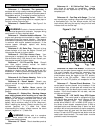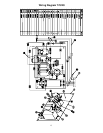
7
connected to a hard starting load such as an air
compressor, it will require more starting current. If it is
connected to a light load or no load such as a power
saw, it will require less starting current. The exact
requirement will also vary with the brand or design of
the motor.
Generators respond to severe overloading
differently than the power line. When overloaded, the
engine is not able to supply enough power to bring the
electric motor up to operating speed. The generator
responds to the high initial starting current, but the
engine speed drops sharply. The overload may stall
the engine. If allowed to operate at very low speeds,
the electric motor starting winding will burn out in a
short time. The generator head winding might also be
damaged.
Running the generator under these conditions may
result in damage to the generator stator as well as the
motor windings. Because the heavy surge of current
is required for only an instant, the generator will not be
damaged if it can bring the motor up to speed in a few
seconds. If difficulties in starting a motor are
experienced, turn off all other electrical loads and if
possible reduce the load on the electric motor.
EXTENSION CORDS
When electric power is to be provided to various
loads at some distance from the generator, extension
cords can be used. These cords should be sized to
allow for distance in length and amperage so that the
voltage drop between the set and point of use is held
to a minimum.
Current/Power Maximum Extension Cord Length
Amps
at
240V
Load
(watts)
#10
Ga.
Cord
#12
Ga.
Cord
#14
Ga.
Cord
#16
Ga.
Cord
10 2400 250’ 150’ 100’ 75’
20 4800 125’ 75’ 50’ 25’
30 7200 60’ 35’ 25’ 10’
40 9600 30’ 15’ 10’ *
50 12000 15’ * * *
*Not recommended
CAUTION: Equipment damage can result from the
low voltage caused by using an extension cord with a
sm all wi re si ze .
Use this chart to estimate the total load on your
generator.
For Determining Generator Load Requirements
Dev ice Running Watts
Air Conditioner (12,000 Btu) 1700 (a)
Battery Charger (20 Amp) 500
Belt Sander (3”) 1000
Chain Saw 1200
Circular Saw (6-1/2”) 900
Coffee Maker 1000
Compressor (1 HP) 2000 (a)
Compressor (3/4 HP) 1800 (a)
Compressor (1/2 HP) 1400 (a)
Curling Iron 700
Dishwasher 1200
Edge Trimmer 500
Electric Nail Gun 1200
Electric Range (one element) 1500
Electric Skillet 1250
Furnace Fan (1/3 HP) 1200 (a)
Freezer 800 (b)
Hair Dryer 1200
Hand Drill (1”) 1100
Hand Drill (1/2”) 875
Hand Drill (3/8”) 500
Hand Drill (1/4”) 250
Hedge Trimmer 450
Home Computer 150
Impact Wrench 500
Jet Pump 800 (a)
Lawn Mower 1200
Light Bulb 100
Microwave Oven 700
Milk Cooler 1100 (a)
Oil Burner on Furnace 300
Oil Fired Space Htr (140,000 Btu) 400
Oil Fired Space Htr (85,000 Btu) 225
Load Requirements, continued
Oil Fired Space Htr (30,000 Btu) 150
Oven 4500
Paint Sprayer, Airless (1/3 HP) 600 (a)
Paint Sprayer, Airless (handheld) 150
Radio 200
Refrigerator 600 (b)
Slow Cooker 200
Subm ersible Pump (1-1/2 HP) 2800 (a)
Submersible Pump (1 HP) 2000 (a)
Subm ersible Pump (1/2 HP) 1500 (a)
Sump Pump 600 (a)
Table Saw (10”) 2000 (a)
Television 500
Toaster 1000
Vacuum cleaner 250
VCR 70
Water Heater 3000
Weed Trimmer 500
(a) Hard-starting motors require 3 to 5 times the
rated running watts.
(b) These loads may require up to 15 minutes to
restart due to its normal build up of compressor head
pressure.
NOTE: For extremely hard to start loads such as
air conditioners and air compressors, consult the
equipment dealer to determine the maximum wattage.
PRE-START PREPARATIONS
Your generator has been thoroughly tested prior to
shipment from the factory. A factory test report has
been included with this manual. However, damage
can occur during shipping, so be sure to check for
damaged parts, loose or missing nuts and bolts. If the
aforementioned problems occur, call customer service
at 1-800-270-0810.
















